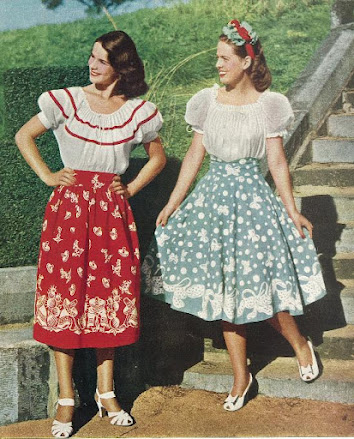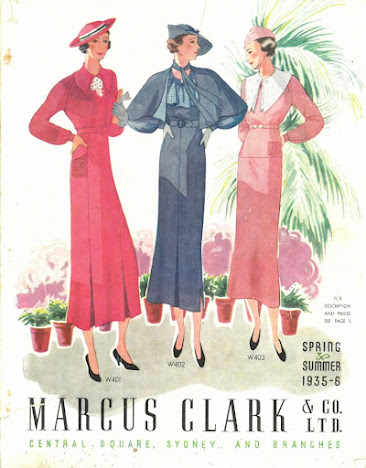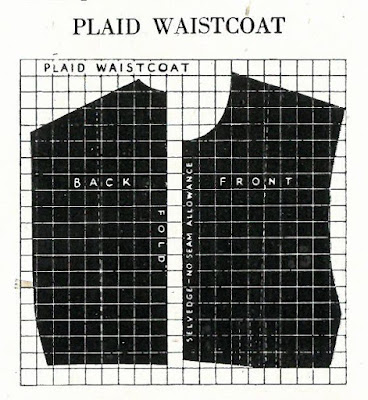In 1930, the questions on every fashion pundit's lips were, "Where was the waistline going to settle?" and, "How far were skirts going to lengthen?"
And the waistline—another very important question! This is as it has been for the past few seasons, a moveable feast. Some dresses show the old normal waistline, in others, the waistline is creeping up to above the hips, giving a different proportion to the silhouette.
The only position the waistline has not yet achieved is under the armpits. But who knows? This may probably be in fashion next autumn.
Australian Home Journal, June 1930
 |
| Weldon's Ladies' Journal, December 1930 |
In other words, belts were going to be literally, as well as figuratively, tightened during the straitened 1930s. My sources indicate that tweed was the most popular material for coats, though other fabrics were worn too.
There is a dashing touch about the coats of this year, suggestive of out-door sports more than sober city occupations. Every flapper sports a tweed coat, or its nearest counterpart. Flannel, by the way, can be obtained in attractive designs, and looks very well when smartly tailored. The great advantage, of course, is that it looks well- and costs less than a good tweed. Particularly smart, for flecked tweed is a style with narrow belt, deep pockets bound with braid, and a scarf collar that can be worn loose, or caught with a pin. Another style has full raglan sleeves, with broad, buttoned cuffs, a very full skirt finish, and stitched inverted pleats at the back.
"Coats are sporting", The Evening News (Rockhampton, Qld.) 8 May, 1930
 |
| Chicago Mail Order, Fall and Winter 1931 |
The Chicago Mail Order catalogue for Fall and Winter 1931 features three of their "Style Queen" coats on the cover. All are very typical of the early 1930s, being slender and fitted to the wearers' figures, belted at the natural waistline and sporting large fur collars.
From left to right we have: an "All wool crepe bouclé" coat with a "genuine natural cat lynx fur" collar, an "All wool monotone crepe coating" with "two voguish ways of wearing the new two-way collars" in fur-effect fabric, and a coat "of Good Quality All Wool Tricot Broadcloth" with a plastron collar of wolf blended dog fur dyed to resemble red fox.
 |
| McCall Style News, November 1923 |
McCall's describes these street coats as being "long and luxurious", and interest is added to the collar and shoulders with—from left to right—an optional cape, a detachable collarette and a fur cloth collar.
 |
| Modes & Travaux, July 1933 |
A new style of coat was introduced in 1933: the swagger coat.
The new "swagger" coat needs no introduction... There will be many of these swagger suits worn.
"Spring Shows Its Influence", Everylady's Journal, August 1933
Coats, even the full length ones, fall from the shoulders, and every designer in Paris shows some version of the three-quarter, bell-shaped coat, hanging coolly, even if it is not so full in the back, while quantities of box jackets are shown everywhere. There is another type of coat that looks new this season. It just meets up the front, instead of overlapping, is frequently buttoned from the top nearly to the knee, and in walking opens below to show the frock.
"Fashion Gossip from Continental Centres", Everylady's Journal, June 1933
Examples of both kinds of coats are shown in the illustration above. The "swagger" or bell-shaped, falling straight from the shoulders, would be a fashion staple for many years to come!
 |
| Petit Echo de la Mode, October 8 1934 |
1934 sees the same mixture of full (but not full length) coats and more fitted coats reaching to the hem of the wearer's dress. All these examples from Le Petit Echo de la Mode are embellished with fur collars and cuffs.
The fashion icon of the day was Marina, Duchess of Kent, and we are told that "Marina blues and greens are all the rage" and
When, however, winter finally comes, coats will be worn that have a still fuller line at the back, and will be often of materials with quilted effects, though corded materials will also be used. Big checks are featured in dull colors and pastel shades which are "delicate without being wishy-washy."
"New Fabric Trends", The Australian Women's Weekly, 9 March 1935
 |
| Singer Easy-to-Make Wardrobe, Fall-Winter 1935 |
In this pamphlet, Singer encourages women to take up sewing by selecting a few paper patterns to make up a complete wardrobe, and comparing the cost of making each garment to the price of buying ready-to-wear. For a coat, Singer chose Pictorial Pattern No. 7927, a swagger coat, and had it made up in "luxuriously soft Kapco all-wool tweed". The estimated price: $6.96, as opposed to an approximate ready-made price between $25.00 and $29.75.
 |
| National Bellas Hess, Midsummer Sale 1936 |
National Bellas Hess describes these coats as "popular swing-back coats" and they were available in various mixtures of wool and rayon, plain or in a fashionable plaid check.
 |
| National Bellas Hess, Fall-Winter 1937 |
All the coats in this catalogue from 1937 have raised sleeve heads (looking almost like leg o' mutton sleeves in some cases), extended shoulders and elaborate collars (some made of fur). Belts seem to have come back into fashion, though they are wider than the belts fashionable earlier in the decade.
National Bellas Hess captioned the first coat "Stand up and Cheer" and the second "The Sweeping Beauty". A particular selling point seemed to be their flared skirts, and the "swagger" appears to be temporarily in abeyance.
 |
| Weldon's Ladies' Journal, November 1938 |
Weldon's offers its readers two free patterns for a "Town Coat With Dolman Sleeve" (left) and a "Smart Fur-Trimmed Winter Coat" (right). "48-inch fur cloth" is suggested for making up the warm and fuzzy looking coat on the left.
Though Weldon's features two slender-line coats on the cover of its "Portfolio of Fashion", there are still plenty of patterns for wider, swagger coats, inside.
 |
| Petit Echo de la Mode, October 1 1939 |
These coats featured in Le Petit Echo de la Mode have a definite (and literal) flair. All the fashion indicators in 1939 pointed towards narrowing waists and broadening skirts.
One look at these new coats will give you their idea; they are shorter than ever and definitely racy.
Most of the coats are quietly and plainly fitted from the waist up; all of them, like everything else this year, are full skirted.
Newest shape is the coachman's coat, a tight-waisted coat cut with a bunch of fullness at the back. And you can't miss the checks; they are as bold and colorful as the parrots at the zoo, done in vivid greens, purples, reds and yellows.
"The New Coats", Australian Women's Weekly, 22 April 1939
However the coming war would put these trends on hold with rationing and shortages—but that's another story. And as spring is around the corner in Australia, I might put this series on hold until the weather turns cold again.

























































